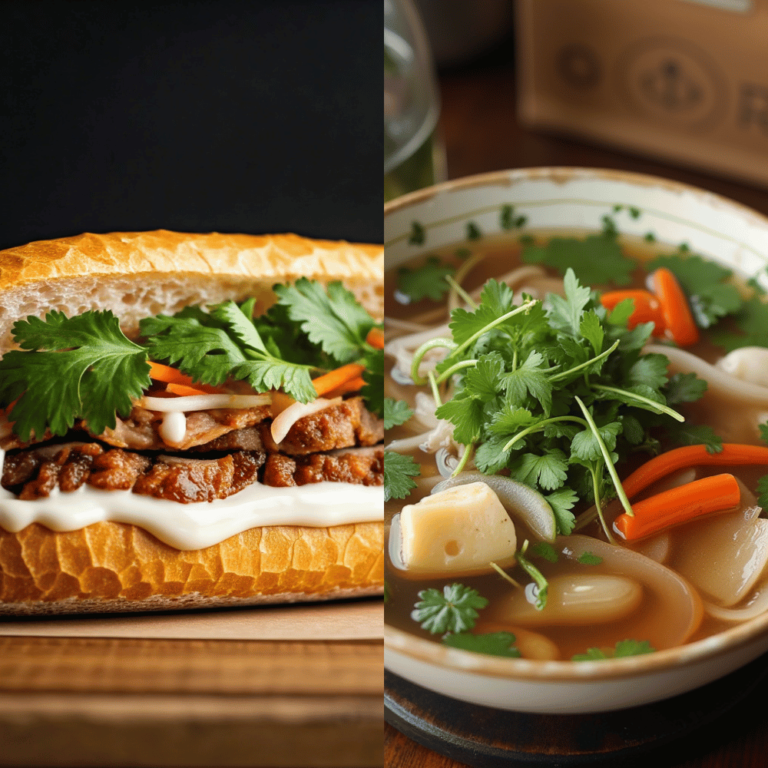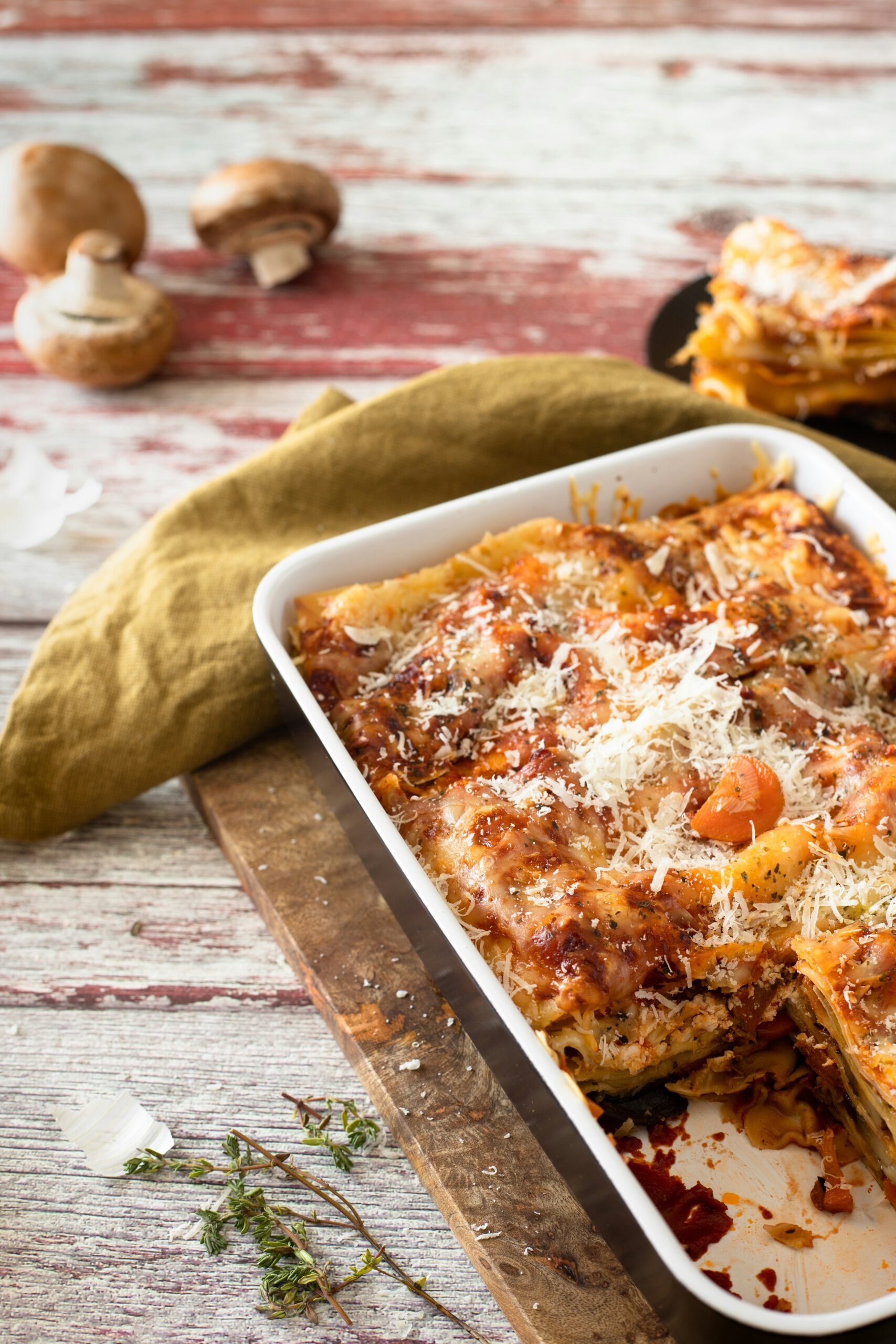Table of Contents
Introduction to Vietnamese Cuisine
Vietnamese food is a culinary tapestry that highlights a balance of fresh flavors, unique textures, and a centuries-old cultural heritage. At its core, the cuisine emphasizes contrasts—sweet and sour, salty and spicy—creating dishes that are both invigorating and satisfying. Freshness is a cornerstone, with vibrant markets supplying ingredients at their peak, ensuring every dish reflects the vitality of its components.
Herbs like coriander, mint, and basil often accompany meals, enhancing their nutritional value and flavor. Pickled vegetables, a common accompaniment, add tangy brightness to sandwiches and other dishes, exemplifying the artful balance in this cuisine. This emphasis on fresh ingredients not only boosts the health benefits of Vietnamese food but also ensures its universal appeal.
Textural variety is another defining feature, with dishes blending crispy, chewy, and soft elements. For instance, Vietnam’s beloved sandwich combines a golden-crusted baguette with savory fillings, while its iconic noodle soup is steeped in an aromatic broth, offering warmth and depth of flavor. These contrasts epitomize the culinary mastery that defines Vietnamese dining.
What is Banh Mi?
It a quintessential Vietnamese sandwich that has gained global recognition for its harmonious blend of flavors and textures. Originating during the French colonial period in Vietnam, he combines the French baguette with traditional Vietnamese ingredients, resulting in a unique culinary creation. The term “Banh Mi” actually refers to the bread itself, but over time, it has come to denote the entire sandwich that incorporates a variety of savory fillings.
The core of a Banh Mi consists of a crispy baguette, which provides a satisfying crunch, often referred to as the Banh Mi crust. The fillings can vary widely, including meats such as grilled chicken, beef, or tofu, catering to a range of dietary preferences. A classic Vietnam’s beloved sandwich typically features pickled carrots and daikon, fresh cucumber slices, cilantro, and chili peppers, creating a delightful contrast to the rich and savory meats. The sandwich is usually enhanced with a spread, which may include mayonnaise or hoisin sauce, further enriching the flavor profile.
Across Vietnam, numerous variations of Banh Mi exist, reflecting regional tastes and available ingredients. For example, in Ho Chi Minh City, diners might find crispy baguette filled with a combination of pâté and cured meats, while in Hanoi, the emphasis may be on grilled meats with fresh herbs. As one explores the streets of Vietnam, they will encounter countless stalls serving this beloved sandwich, each offering its unique take on the classic Banh Mi. Many local food enthusiasts often search for Banh Mi near me to indulge in these flavorful delights. This sandwich epitomizes Vietnamese food culture, seamlessly marrying the French influence with traditional Vietnamese ingredients, making it a must-try for anyone exploring the diverse flavors of this captivating country.

The Banh Mi Crunch
The iconic Vietnamese dish, banh mi, is renowned not only for its flavorful fillings but also for the essential textural contrast generated by its crusty baguette. This crispy exterior is one of the defining characteristics that elevate banh mi beyond a mere sandwich into a culinary sensation. A well-structured banh mi should exhibit a crust that is both crunchy and flaky, providing a satisfying bite that complements the meat, herbs, and pickled vegetables nestled within.
To achieve the perfect crunch when preparing banh mi at home, it is crucial to select the right type of bread. Traditional Vietnamese baguettes, made with a combination of wheat and rice flour, deliver an airy structure with a thin, crispy crust. When baking at home, consider adjusting the oven settings to create a hotter environment, which will help the crust develop a beautiful golden brown finish. A few tricks, such as placing a pan of water at the bottom of the oven, can also create steam that contributes to a crunchier texture.
Furthermore, the choice and preparation of the vegetables can greatly enhance the overall crunch of the banh mi experience. Fresh cucumbers, shredded carrots, and daikon radish add not just texture but also vibrant flavors that balance the savory fillings. For the ultimate satisfying bite, ensure these vegetables are thinly sliced and fresh; they serve as a refreshing contrast to the richness of proteins like chicken. Incorporating herbs such as cilantro and mint can also add layers of texture and flavor, supporting the idea that Vietnam’s beloved sandwich is a harmonious blend of taste and crunch.
Incorporating these elements not only elevates the banh mi experience but also connects consumers to the culinary traditions of Vietnam, paving the way for a deeper appreciation of this beloved dish.
Understanding Pho Broth
This iconic dish is the essence of Vietnam’s beloved noodle soup, and its preparation is an art that requires time, patience, and understanding of the ingredients. The foundational base of pho is typically made from beef bones, often containing marrow, which imparts a rich, deep flavor to the broth. Simmering these bones for an extended period—sometimes up to several hours—allows for the extraction of flavors, resulting in a broth that is both savory and aromatic. For those who prefer a lighter version, chicken bones are commonly used, yielding a different, yet equally delightful, pho broth.
The aromatic component of pho broth is enhanced through the use of various spices. Traditional spices typically include star anise, cloves, cinnamon, and coriander seeds. These ingredients are usually toasted first to heighten their flavors before being added to the simmering stock. Meanwhile, onions and ginger are charred over an open flame to create a smoky depth that complements the spices, further enriching the broth’s complexity.
Cooking techniques also play a crucial role in creating pho broth. After the bones and spices are combined with water, the mixture is brought to a boil and then immediately reduced to a gentle simmer. This slow cooking process helps to develop the broth’s flavor profile and ensures clarity, as impurities are carefully skimmed off the surface. The final product is a clear, richly flavored soup base that serves as a perfect partner for the rice noodles and a variety of fresh toppings in a bowl of pho.
The cultural significance of pho in Vietnamese dining cannot be understated. It is more than just a meal; it embodies tradition, warmth, and family. Often enjoyed at breakfast but also popular throughout the day, pho has become an integral dish in Vietnamese cuisine, resonating with locals and travelers alike. Its evolution over the years has led to the emergence of various adaptations, including the innovative pho banh mi, which combines the traditional sandwich with the flavors of pho. Thus, the intricacies of pho soup mirror the rich tapestry of Vietnamese food culture, marking its importance in every bowl served.
The Art of Making Pho Broth
Creating an authentic pho broth at home is a rewarding culinary endeavor that pays homage to the rich traditions of Vietnamese food. The foundation of a great pho lies in selecting the right marrow bones and spices. Ideally, one should opt for a combination of beef bones, such as oxtail or shank, since their marrow contributes to the deep, rich flavor desired in a pho broth. Roasting the bones in the oven for about 30 minutes enhances their flavor significantly, creating a toasted depth that infuses the broth with complexity.
Once the bones are prepared, it’s essential to gather the right spices to replicate the aromatic essence of traditional pho. Commonly used spices include star anise, cinnamon sticks, cloves, and coriander seeds. The combination of these spices not only imparts warmth but also an unmatchable fragrance. To extract their full potential, toast the spices lightly in a dry pan before adding them to the broth. This step activates their essential oils and elevates the overall taste.
Next, combine the roasted bones with water in a large pot and begin the simmering process. Bringing the mixture to a gentle boil, followed by reducing the heat to a slow simmer for several hours, allows for the perfect extraction of flavors. A simmering time of 6-8 hours is recommended for achieving that deep umami flavor characteristic of this iconic dish. Remember to regularly skim the surface for impurities to ensure a clear broth.
After this lengthy process, the broth should be divinely fragrant and rich. Before serving, strain the broth to remove the solids, leaving a crystal-clear liquid that’s ready to be enjoyed. Pho broth forms the heart of pho and can be complemented beautifully by the addition of banh mi crust, creating a delightful culinary experience. With a bit of patience and care, anyone can master the art of making hem at home, capturing the essence of this iconic Vietnamese dish.
Pairing of this two iconic dishes
The culinary experience of Vietnam is notably enriched by the harmonious pairing of this iconic dishes. Each dish brings distinct elements to the table, enhancing the overall appreciation of Vietnamese food. Banh mi, a traditional Vietnamese sandwich, is characterized by its crisp baguette, vibrant pickled vegetables, fresh herbs, and a choice of flavorful proteins. This dish provides a delightful contrast in texture and taste, making it a versatile addition to any meal.
On the other hand, pho broth stands out with its rich, aromatic qualities derived from simmering beef bones or chicken with an array of spices such as cinnamon, star anise, and ginger. The resulting pho broth soup offers a warm and comforting experience, perfectly complementing the freshness of banh mi. The depth of flavor found in pho soup enhances the various fillings within the sandwich, allowing ingredients to shine while providing a balanced meal.
When enjoying them together, one can appreciate the interplay of flavors. For example, the crunchiness of the banh mi crust pairs exceptionally well with the warmth of the pho broth, creating a sensory experience that captivates the palate. Additionally, dipping bites of banh mi into a bowl of pho soup can elevate the taste, as the broth seeps into the sandwich, melding flavors in a delightful fusion.
For those seeking authentic experiences, searching for “pho broth near me” can yield local eateries offering captivating renditions of these classic dishes. Ultimately, the combination of banh mi & pho not only showcases the diversity of Vietnamese cuisine but also invites diners to indulge in a meal that balances texture, flavor, and cultural heritage seamlessly.
Regional Variations of Banh Mi and Pho broth
Vietnamese cuisine is celebrated for its rich diversity, particularly evident in its iconic dishes: banh mi and pho. These culinary staples are not only popular within Vietnam but also enjoyed worldwide, leading to numerous adaptations. However, the true essence of banh mi and pho can be appreciated by examining the regional variations that arise from Vietnam’s geographical diversity.
Starting with banh mi, this Vietnamese sandwich offers a myriad of flavors based on location. For instance, in Ho Chi Minh City, the crispy baguette is often characterized by its French influence, incorporating pâté alongside grilled meats, pickled vegetables, and fresh herbs. However, in the north, particularly in Hanoi, the sandwich tends to be simpler, focusing primarily on chicken and garnishes such as coriander and cucumber. This distinction highlights how geography and available ingredients shape the flavor profile of banh mi, making it a dynamic dish that changes from region to region.
Similarly, pho, the beloved Vietnamese noodle soup, showcases regional differences primarily through its use of beef or chicken, as well as the spices and herbs that flavor the broth. In the central regions of Vietnam, such as Hoi An, the pho is often enriched with a deeper seasoning blend, providing a richer, more robust flavor. In contrast, Northern pho emphasizes a cleaner taste, with a lighter broth often accompanied by minimal garnishes. Those seeking authentic pho broth will find that the different regions offer unique options, allowing diners to explore variations from street vendors to upscale restaurants.
In conclusion, both banh mi and pho demonstrate how regional ingredients, cooking methods, and cultural influences contribute to their unique flavors. Travelers and food enthusiasts looking for “banh mi near me” or “pho broth near me” are bound to discover an exciting array of dishes that reflect the history of Vietnamese food and its regional nuances.
Health Benefits of Banh Mi and Pho Broth
this combination are not only delightful representatives of Vietnamese food but also pack a host of health benefits due to their fresh ingredients and nourishing components. Banh mi, typically composed of a French baguette filled with lean proteins such as grilled chicken, offers a balance of macronutrients through its combination of carbohydrates, protein, and vitamins from fresh vegetables. The inclusion of cilantro, cucumber, and carrots enriches the dish with essential nutrients and antioxidants, which can support overall health.
On the other hand, pho broth, the star of pho dishes, is renowned for its comforting qualities and rich flavors, yet it serves a greater purpose. Made by simmering bones, herbs, and spices for hours, pho soup is not just a flavorful addition but also a source of minerals and collagen, which can be beneficial for joint health and skin elasticity. Having pho broth soup as a base offers a low-calorie option that can help individuals maintain a balanced diet without sacrificing taste.
To enhance the health benefits of these dishes, consider making a few modifications. For banh mi, opt for whole-grain baguettes to boost fiber intake or substitute traditional meats with grilled tofu for a vegetarian option that doesn’t compromise on flavor. When preparing pho, prioritize lean cuts of meat and opt for homemade broth to control sodium levels and avoid additives found in store-bought versions. Additionally, incorporating a bounty of vegetables into both banh mi and pho can enhance nutritional value, providing more vitamins and minerals while ensuring that each bite is packed with flavor.
Incorporating these health-focused modifications allows both banh mi and pho to fit seamlessly into diverse dietary lifestyles while still delivering the authentic taste of Vietnamese cuisine. With the variety of fresh ingredients, these dishes remain a guilt-free indulgence, making them a popular choice among food enthusiasts seeking health-conscious options.
Conclusion: A Culinary Journey through Vietnam
As we conclude our exploration of the rich culinary landscape of Vietnam, it is clear that dishes such as banh mi & pho broth are not merely meals but rather profound representations of the country’s cultural heritage. The pho banh mi combines the best attributes of two iconic dishes, creating a unique dining experience that captures the essence of Vietnamese food. Each bite offers a delightful amalgamation of textures and flavors, showcasing the harmonious blend of spices, herbs, and fresh ingredients characteristic of Vietnamese cuisine.
The cultural significance of banh mi is deeply rooted in Vietnam’s history, influenced by French colonialism while simultaneously embodying local traditions. This sandwich, often filled with savory meats, pickled vegetables, and aromatic herbs, exemplifies the creativity and adaptability of Vietnamese street food. Similarly, pho broth, a quintessential component of Vietnam’s national dish, is not only beloved for its comforting qualities but also serves as a social glue, bringing families and friends together over bowls of steaming pho broth soup.
For readers intrigued by these culinary delights, we encourage you to explore banh mi near me or search for pho broth near me to uncover local Vietnamese restaurants that serve these traditional dishes. Alternatively, cooking enthusiasts can engage in the delightful challenge of recreating these flavors at home, experimenting with various ingredients to craft the perfect banh mi crunch or a rich and aromatic bowl of Vietnamese food. The journey into Vietnamese cuisine is one marked by discovery and enjoyment, offering endless opportunities to expand your palate and deepen your appreciation for this vibrant culture.




Pingback: Banh Mi: Savor Vietnam’s Famous Sandwich Like Never Before